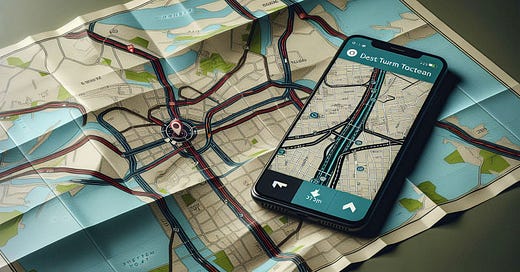Project Plans Are a Map, Not Directions
Why your turn-by-turn project is setting you up for failure.
I had an epiphany* about project planning while hiking in Northumberland. We had detailed directions from our guidebook: "Turn left at the signpost by the old oak, cross the stream after 400 metres..." But when we got there, the signpost and oak had fallen in a storm, and the stream flooded to be practically a lake, and our carefully described route was useless. What saved us? The guidebook (one of the very excellent Ordnance Survey Pathfinder Guides) includes a copy of the local OS map with every walk - giving you options to alternative paths, higher ground and effectively different routes to your destination.
This exactly mirrors my journey with project planning. When I started, I used to create detailed, turn-by-turn instructions for projects: we’ll do A, then B, then C. The plans looked perfect... until we actually started executing them. Then reality would hit, and I’d waste time trying to force-fit our work into outdated directions instead of finding better routes.
The Directions Trap
Traditional project planning often feels like following GPS directions:
Take specific actions in a specific order
Follow precise timelines
No context for decisions
One "optimal" route
When blocked, wait for "recalculating..."
This approach fails because it assumes near perfect knowledge of conditions ahead, it provides no context for decision-making later, and it breaks down completely when you hit an obstacle.
The Map Mindset
Instead, think of your plan as a map, that
Shows multiple possible routes
Provides context and terrain
Has different levels of detail (detailed for next steps, rougher for distant areas)
Clear landmarks for orientation
Helps you route around obstacles
I referenced this mindset shift before in A Plan is a Basis for Change, but this really shifts how you plan and execute:
1. Create Different Levels of Detail
Just like a map shows major highways and local streets:
Detailed, specific plans for immediate next steps
Medium-term milestones with multiple approaches
Long-term goals with rough direction only
Key decision points where routes diverge
2. Mark Your Landmarks
Maps help you orient yourself with prominent features:
Clear milestone deliverables
Customer feedback checkpoints
Technical metrics
Resource markers
Early warning indicators
3. Plot Multiple Routes
Don't just show one path - explicitly map out:
A set of principal routes with known challenges
Alternative approaches for common obstacles
Escape routes if things go badly
Scenic routes for when you have extra time/resource
Shortcuts for when you're under pressure
Making It Work in Practice
Continuing the metaphor, here's a way to implement this approach:
1. Start with the Terrain
Map out known constraints
Identify major obstacles
Mark areas of uncertainty
Show where you need more detail
2. Plot Your Checkpoints
Key decision points
Places to check position
Points of no return
Resource resupply points
3. Keep Updating Your Map
Add detail as you learn more
Mark discovered obstacles
Note successful routes
Share updates with the team
4. Teach Map Reading
Help your team understand the context
Make route-finding a team skill
Encourage active navigation
Celebrate good route choices
The Fuller Value of Mapping
Making a good map gives you much more than just a GPS route - it helps you:
Understand your options
Make informed decisions
Find alternative routes
Share context with others
Learn the terrain for next time
When you approach planning this way, your team starts thinking differently. Instead of blindly following directions, they become active navigators, spotting issues early and suggesting better routes.
The Bottom Line
A good plan, like a good map, doesn't just tell you where to go - it helps you understand where you are and what options you have. When you treat your plan as a map rather than a set of directions, you create the context your team needs to navigate successfully, even when conditions change.
Remember: The best explorers don't just follow directions - they use (or create!) maps to understand their options and make good choices as they discover what lies ahead.
---
* For “had an epiphany” you could instead read “had moment of clarity and then got excited, forgetting that I was cold and wet on a Northumberland hillside” but that doesn’t have quite the same ring to it.





